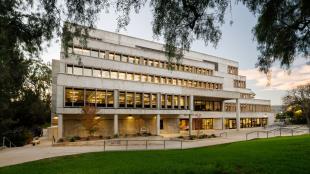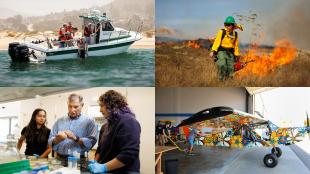A Mace, Mortal Kombat and One Very Proud Family: Six Things to Know About Cal Poly Commencement
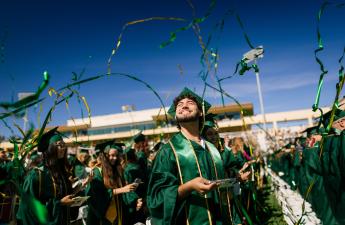
This weekend, hundreds of new Cal Poly graduates will walk across the stage at Spanos Stadium and on to the next chapter of their lives.
It’s a joyous occasion full of pomp and circumstance — and some interesting history. Here are six fun facts about commencement.
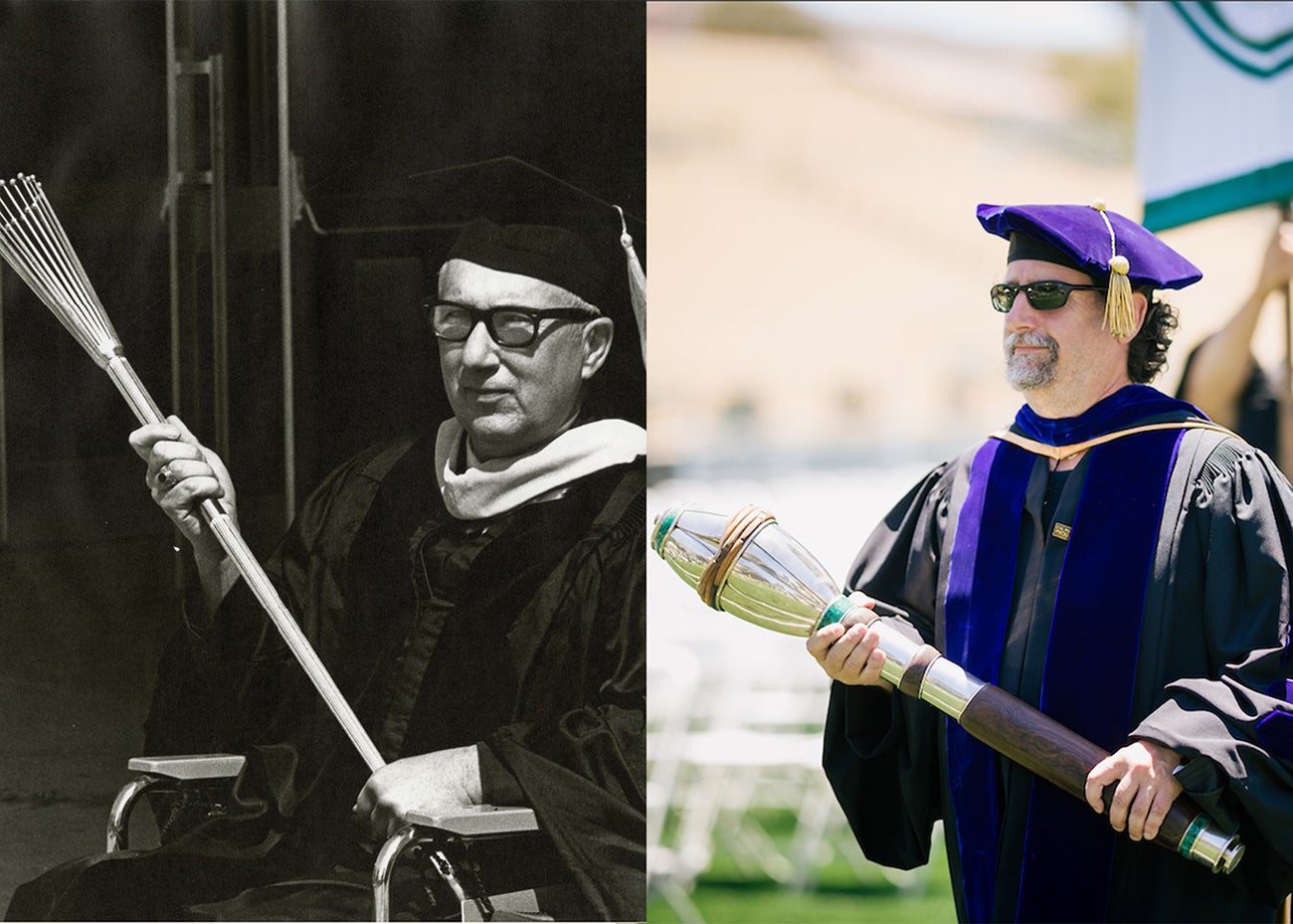
The Mace
During the opening academic procession, ahead of the throng of college banners and robed dignitaries, you’ll spy someone carrying a club-like artifact that would look more at home in a museum. It’s a ceremonial mace: a symbol of authority, university bona fides and gravitas.
Cal Poly has had two maces over the last 116 years. The first one was designed by faculty member Thomas Johnston, built by the College of Engineering’s Manufacturing Processes Department and used in commencements from 1968 to 2000. It now lives in University Archives, where many first-time visitors look and wonder at what Kennedy Library archivist Laura Sorvetti describes as that “interesting-shaped item.” Common guesses include giant head massager and musical device, she said.
Cal Poly Professor Crissa Hewitt, now an emeritus professor, was selected to create “a more contemporary design” for the university’s centennial in 2001, which is the mace still used today.
Hewitt’s mace features a stylized club, roughly the shape of a big-barrel T-ball bat, made of sterling silver, gold, teak and rosewood. The Cal Poly colors of green and gold are also part of the mace, with green malachite chip inlays in the handle and a cast gold flame element at the top.
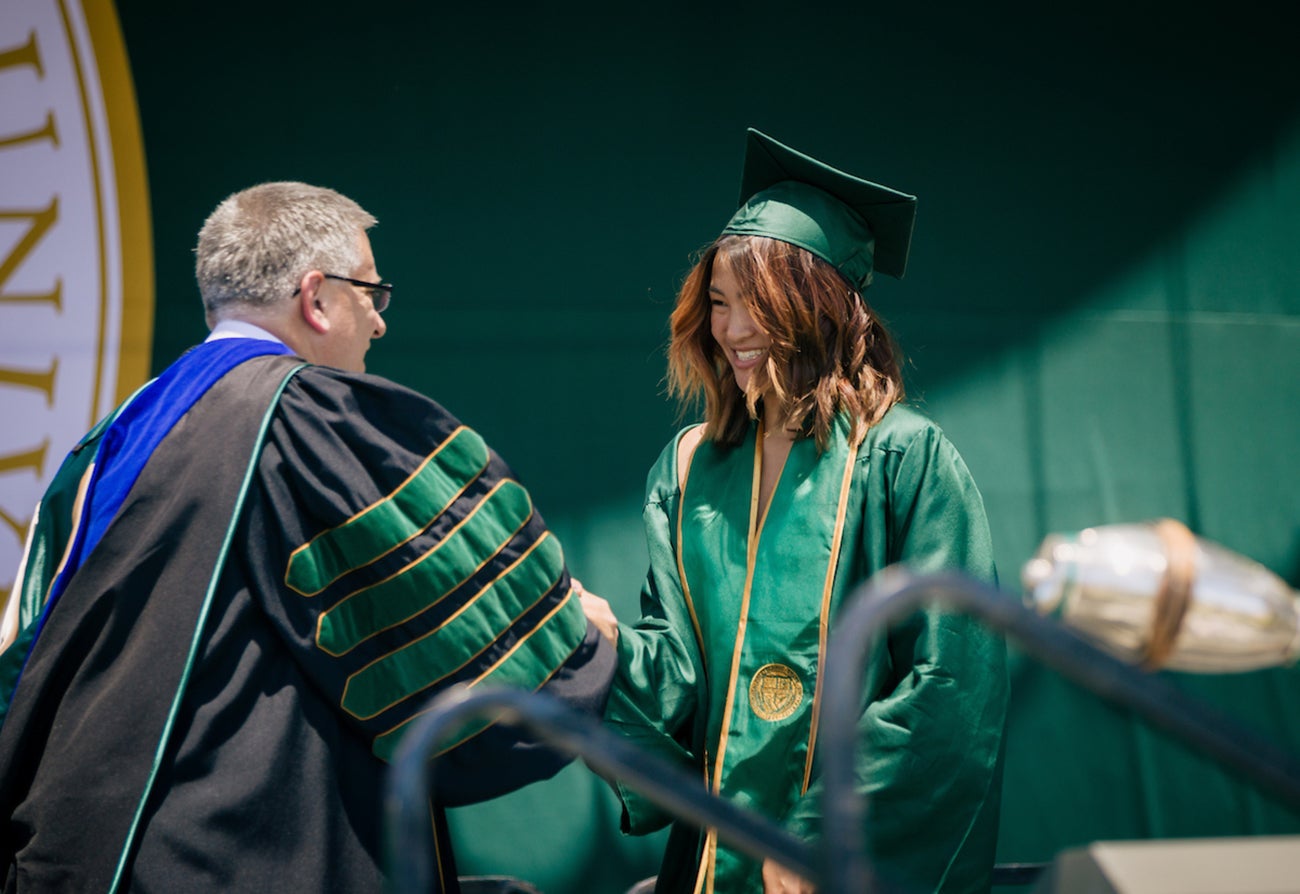
The Voices Behind the Names
In 2016, two trained, professional name readers were added to the commencement ceremony to ensure that each graduate’s name is heard loudly and proudly.
David Markus, a prolific voice actor since he was a teenager, has been a reader at Cal Poly for six years. He is an in-demand voice performer for commercials and podcasts as well as acting roles in television series, video games and animation.
On the other side of the stage is Jamieson Price, an actor who’s worked on stage, screen and microphone. He began announcing the names of graduates at Cal State Long Beach commencement ceremonies over 20 years ago, and now serves Chapman University and Cal Poly during graduation season.
Price has appeared in films like “The Patriot” and “The Secret Kingdom,” and on TV in “Without a Trace,” “Westworld,” “Frasier.” His voice is especially iconic for video game fans: He was the announcer in the game Mortal Kombat, delivering the brutal command, “Finish him!”
Price takes his work as a name reader seriously, knowing that every name belongs to an individual and is special. A few years ago his daughter graduated from Long Beach State, and he was able to read her name as she glided across the stage.
“It’s a very proud moment,” he said. “It’s a real moment of accomplishment and achievement for the students and a rite of passage in some ways. They enter college still as kids, kind of, and they come out of it like you are in the real world now. And it’s an exciting thing to have your name said like that.”
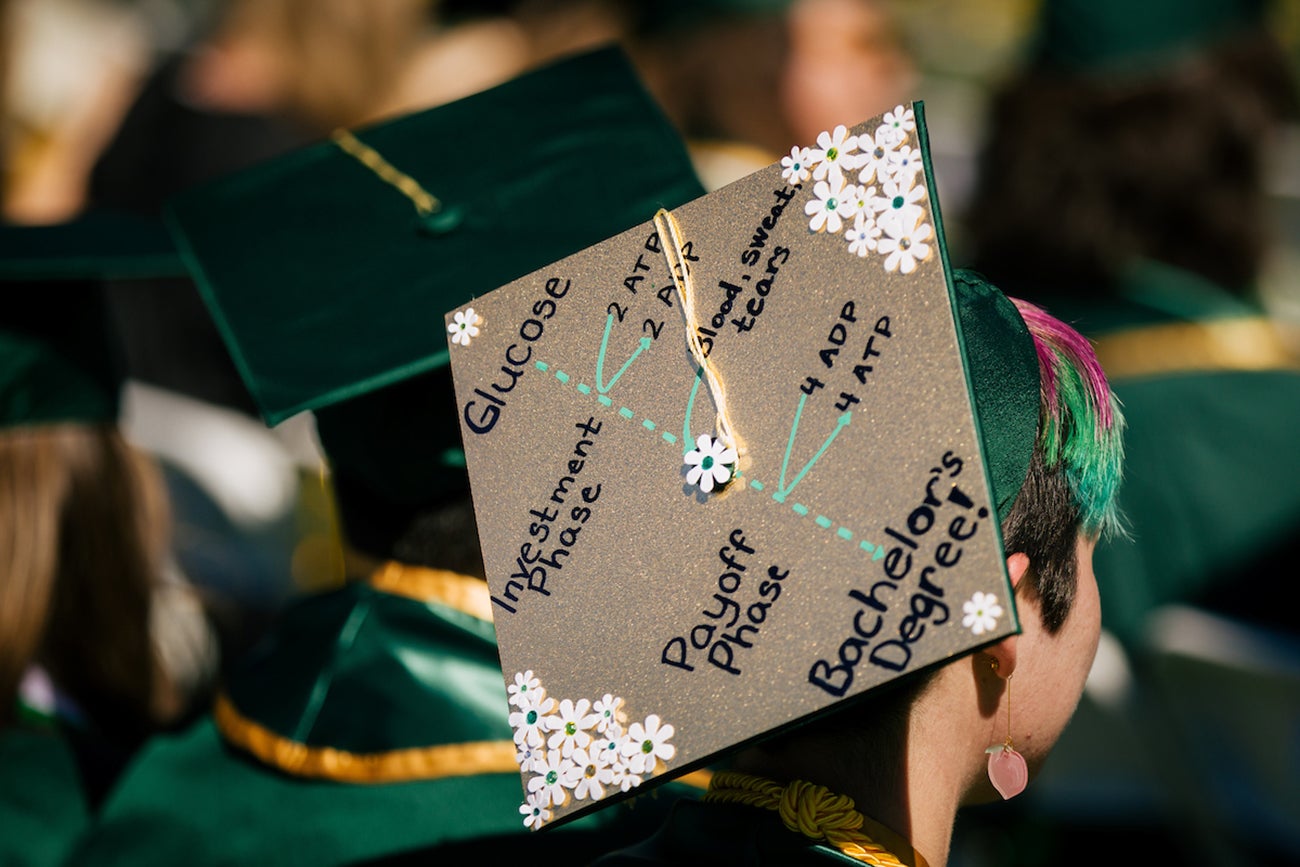
The Tassel is Worth the Hassle
In 1968, controversy broke out ahead of commencement, as faculty members begged then-president Robert E. Kennedy to do something about a serious issue of student decorum: decorations on their mortarboard caps.
To alleviate the crisis, Kennedy proposed official color-coded tassels to give the students some individuality based on their majors — a tradition that lives on to this day, even though decorations are no longer frowned upon. Here’s a guide to the meanings behind the rainbow of tassels you’ll see at this year’s commencement ceremony.
Maize – All College of Agriculture, Food and Environmental Sciences degrees
Blue-Violet – Architecture
Orange — Architectural Engineering
Brown — All other architecture degrees
Sapphire Blue — Industrial Technology
Drab — All other Orfalea College of Business degrees
Orange — All College of Engineering degrees
White — All College of Liberal Arts degrees, Extended Education
Light Blue — Master of Arts in Education
Sage Green — Kinesiology
Golden Yellow — All other Bailey College of Science and Math degrees
One more tassel tip: Bachelor’s candidates wear tassels on right side of their caps until their degrees are conferred, then move to the left; graduate students wear them on the left from the beginning.
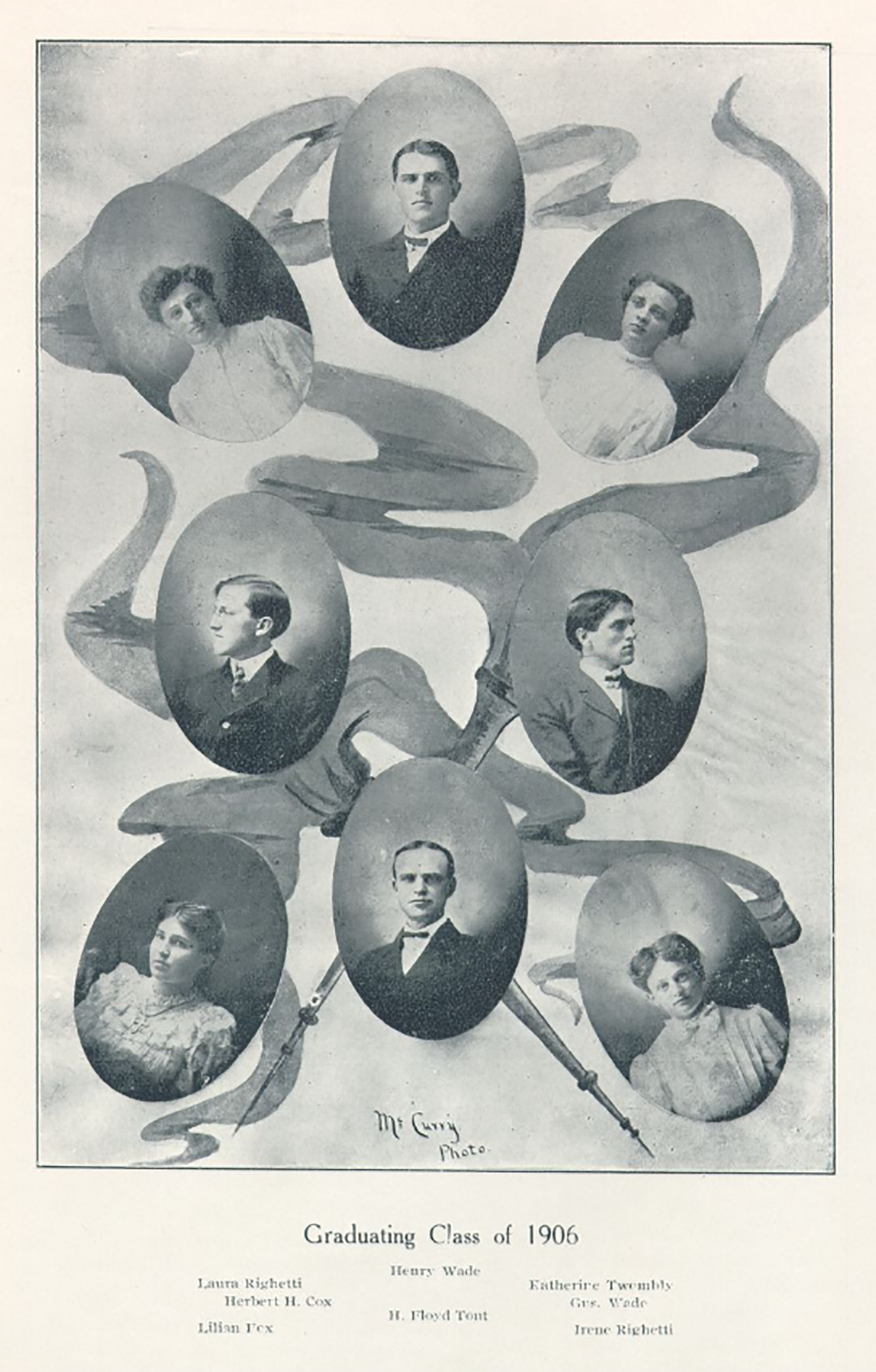
The Fateful Eight
Though Cal Poly was founded in 1901, the first graduation ceremony was held June 15, 1906, just three years after classes started at the polytechnic vocational school — not a college or university then. Just eight students — an even match of girls and boys — made up the Class of 1906.
That first class successfully completed the Agriculture, Mechanics, and Household Arts programs — the only programs offered at the time. The three main campus buildings they knew no longer exist: the original main administration building and boys’ dormitory were leveled in the early 1940s to make room for a modern administration building and clock tower, while the Science Building was demolished in 1974 to create space for the Architecture Building.
Those eight grads left behind two gifts: a “class tree,” a valley oak that still stands tall on California Boulevard; and the commemorative spade they used to plant it that in turn was used for decades of class tree plantings, and now lives in University Archives. The students of 1906 penned a history of their class, left a class will and offered a class prophecy. See more in the Polytechnic Journal, via University Archives.

Three Sisters, One Commencement Weekend
It’s going to be a busy weekend for the Arredondo family of Santa Maria who will watch three sisters receive bachelor’s degrees over both days.
Marine sciences major Stephanie, 25, business administration major Erica, 23, and environmental engineering major Clarissa, 21, didn’t plan on graduating together, but an unexpected turn of events led to the three finishing their undergraduate degrees on the same weekend.
The sisters represent the different pathways students Cal Poly students can take as they obtain a degree. Clarissa started at Cal Poly in the fall of 2019, just a few months after finishing high school, and followed a four-year path. She was a member of the Cal Poly Scholars that provided financial, academic and community resources to foster student success for members who represent all six colleges in more than 50 majors.
Stephanie and Erica both began their Cal Poly studies as transfer students at the start of the 2021 academic year, five and three years after high school graduation, respectively. Both struggled initially with the transition from semester studies to the faster-paced, 10-week quarter system, but each found campus resources that helped them get into the rhythm of the university’s unique school year.
The three sisters, who are the first in their family to receive four-year degrees, are thankful to family who pushed each to work hard and inspired them to do their best. They’re also grateful for support from various Cal Poly programs that provided resources and scholarships, and faculty who offered encouragement and advice when coursework proved difficult.
“Our family is very proud of us and of the journeys that we took to get to this place in life,” said Stephanie. “Cal Poly has opened up many opportunities that I don’t think I would have experienced at any other college.”

By the Numbers
The 2023 commencement celebration will be held at 8:30 a.m., 12:30 and 4:30 p.m. each weekend day in Spanos Stadium on June 17 and 18. An estimated 50,000 guests are expected throughout the weekend. More than 5,000 Cal Poly students are eligible to graduate, and organizers expect 90% of them to attend.
The College of Engineering will have the largest number of total undergraduate and graduate students at commencement, while business administration in the Orfalea College of Business is the largest program. The College of Architecture and Environmental Design, while the smallest college at commencement, nevertheless has two of this year’s 10 most popular programs.
Colleges by Total Graduates
1. College of Engineering: 1,254
2. College of Agriculture, Food and Environmental Sciences: 952
3. College of Liberal Arts: 881
4. Orfalea College of Business: 838
5. Bailey College of Science and Mathematics: 673
6. College of Architecture: 420
Most Popular Undergraduate Majors
1. Business Administration (OCB): 644
2. Mechanical Engineering (CENG): 198
3. Computer Science (CENG): 166
4. Biological Sciences: (BCSM): 158
5. Architecture (CAED): 150
6. Animal Science (CAFES): 138
7. Civil Engineering (CENG): 136
8. Psychology (CLA): 127
10. Construction Management (CAED): 117
10. Environmental Management and Protection (CAFES): 117
Most Popular Graduate Degrees
1. Business Analytics (OCB): 39
2. Biomedical Engineering (CENG): 37
3. Computer Science (CENG): 37
4. Agricultural Education (CAFES): 34
5. Mechanical Engineering (CENG): 34
6. Civil and Environmental Engineering (CENG): 31
7. Engineering Management (CENG): 26
8. Electrical Engineering (CENG): 25
9. Business Administration (OCB): 23
10. Biological Sciences (BCSM): 22
This story is an update to a similar piece from Commencement 2022.

